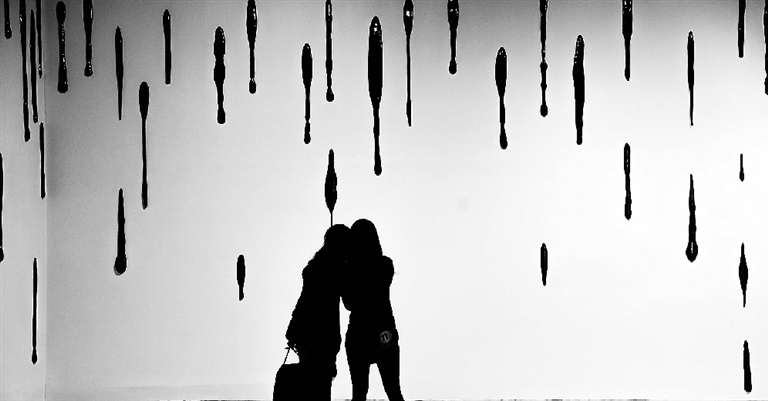

Cao Zhen caozhen0806@126.com WITH a searing hot name, “1342°C” is a cool exhibition. From his ink droplets-shaped “Trace,” simple “Blank Paper” and lifelike “Fallen Leaves” to a whole room of smashed porcelain garbage, Chinese artist Liu Jianhua demonstrates the diversity of porcelain and his continuous reinvigoration of the medium through experimental approaches and unconventional aesthetics. Now he has brought several of his famous artworks to OCAT Shenzhen. “The highest temperature used for firing ceramics is 1,342 degrees Celsius. In Liu’s porcelains, the traditional and the contemporary, as well as the natural and everyday attitudes and feelings, have been infused into the glaze of these objects,” said Feng Boyi, one of the curators of the exhibition. Liu’s porcelains created in the 1990s feature strong, bright colors, reflecting social change and Chinese culture within the context of globalization. In 2008, he developed his “no meaning, no content” concept, referring to the present lack of human spirit and ignorance of social history and culture around the world. From then on, he mainly has used cold colors in his works to convey “quiet aesthetics,” which include the items at the Shenzhen exhibition. “Trace” (2011), a series of wall-bound black porcelain ink droplets, is inspired by a calligraphy stroke called “traces from a leaking roof.” The work transforms the white walls of the exhibition hall into an immense sheet of paper, and the lustrous black porcelain “ink droplets” appear to drip down the walls. His “Blank Paper” series (2008-2019) consists of thin, white, rectangular porcelain pieces which look like blank sheets of paper mounted on the walls, leaving visitors to fill in the paper with their own thoughts. Liu also produces porcelain replicas of ordinary objects, such as fallen leaves, sand, ropes and rime tree branches, to highlight their symbolic meanings to magical effect. “The technique is not difficult, but how you use it to express yourself is more important,” said Liu at the opening of the exhibition last Saturday. “I want to use traditional material to express my feelings, my perception of the world and form my unique artistic language.” Born in Jiangxi Province, Liu began learning making ceramics at a factory in China’s “Porcelain Capital” of Jingdezhen at age 14. Eight years later, unsatisfied with making crafts for decorations, he furthered his studies in sculpture at the Fine Arts Department of Jingdezhen Ceramic Institute. After graduating in 1989, he taught at the Department of Sculpture of Yunnan Arts University in Kunming. He once said that his university experience and artist friends have influenced him to embark on a journey of contemporary art. His porcelains and mixed media works have been collected by numerous foreign art museums and exhibited at international biennales. Liu now teaches in the Sculpture Department of Shanghai University’s Fine Arts College. His “Color” (2016-2019), a set of colorful clay mounds with cracks on the surface, also communicates his views on the past and present. “I kneaded clay everyday when I was 14 at the ceramic factory and now I regard this tiring and time-consuming process as very artistic. The colors I applied on the dry clay mounds with cracks show the clay’s tranquil appearance containing an inner strength,” said Liu. Occupying the entire Hall B of OCAT Shenzhen, “Discard” (2001-2011) is made up of abandoned porcelain fragments which are ubiquitous in Jingdezhen. The artwork reflects a conflict with the spatial perception of reality in the form of estrangement. As a sculptor, Liu has a keen sense of space, so when preparing “Discard” for Shenzhen, he considered several ways of doing it. “I intended to invite visitors to walk into the ‘porcelain garbage dump,’ but later I decided to let them stand aside or walk onto a ladder to see it from above. I hope visitors will feel the mood I try to present,” he said. Dates: Until April 7, 2020 Hours: 10 a.m.-5:30 p.m., closed Mondays Venue: OCAT Shenzhen, South Area, OCT-LOFT, Nanshan District (南山区华侨城创意文化园南区OCAT深圳馆) Metro: Line 1 to Qiaocheng East Station (侨城东站), Exit A
| 
